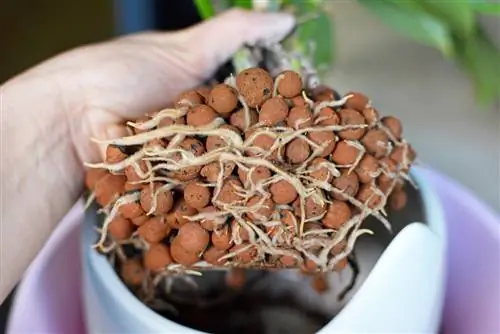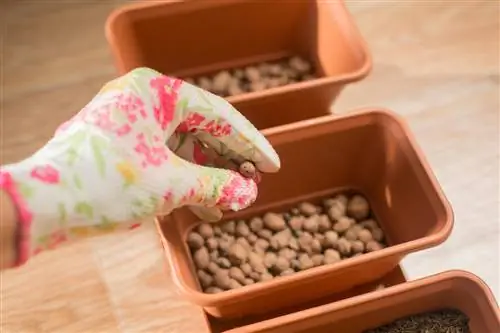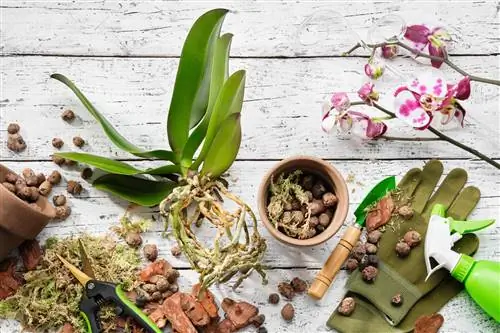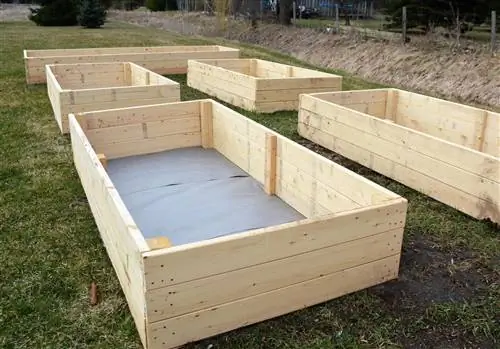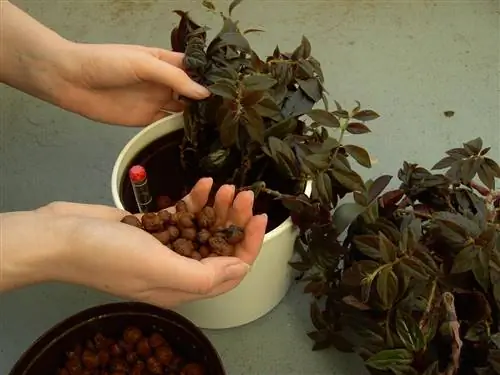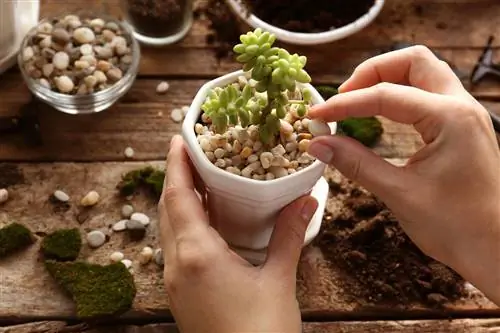- Author admin [email protected].
- Public 2023-12-26 14:17.
- Last modified 2025-06-01 06:02.
Expanded clay is a prime example of successful collaboration between people and nature. This guide explains how expanded clay is created and provides important information about its properties. Explore the versatile uses for gardening, plant care and house building. You can find out where you can buy the beneficial natural material here, including an informative price comparison.
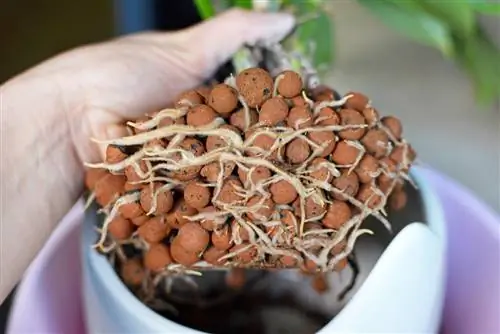
What is expanded clay?
Expanded clay is fired, granulated clay. It expands into small balls at 1200 °C. The natural product is used in plant care and in the garden. It can improve the soil or serve as a drainage substrate in raised beds.
- Expanded clay is granulated, fired clay that expands many times over into small balls at 1200° Celsius.
- Expanded clay is germ-free, rot-proof, frost-proof, dimensionally stable, fireproof and insulating. Expanded clay balls have a closed-pore core with a porous surface so that water is absorbed and drained away, but not absorbed.
- Expanded clay can be used as a natural product for garden and plant care as well as in ecological house building.
What is expanded clay?
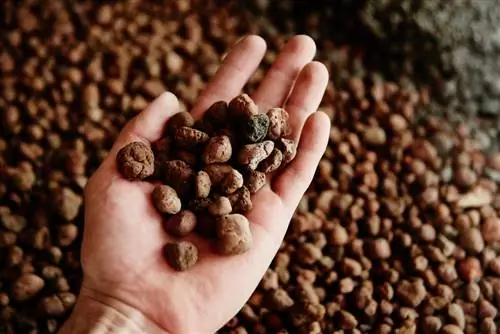
Expanded clay consists of low-lime clay and many, many air bubbles
The starting material for expanded clay is low-lime clay with organic components and no chemical additives. For production, mined clay is ground and fired in an oven at 1200° Celsius. During this process, the organic components in the clay balls burn, causing them to expand many times over. The result is a light and round shaped granulate with the apt name expanded clay or clay granulate. The following properties characterize expanded clay:
- germ-free: does not mold
- neutral: no influence on the pH value
- structurally stable: pressure-resistant, prevents compaction and waterlogging in soil
- weather-resistant: can be used outside and inside
- indestructible: inorganic, does not decompose
- fireproof: non-flammable
- insulating: good sound insulation, medium thermal insulation (0, 10-0, 16 W/mK)
- environmentally friendly: contains no chemical additives
During the firing process, expanded clay balls are created with a closed-pored core, which is surrounded by a sintered, fine-grained surface. This process has a decisive influence on behavior in water. Expanded clay absorbs moisture in its shell. However, the closed-pored core prevents water from being absorbed.
Expanded clay was invented in the USA at the beginning of the 20th century by S. Hayde, to which the American name Haydite refers. The internationally common brand name for expanded clay is Leca, an abbreviation for lightweight expanded clay aggregates. A rarer name is Keramsit.
What can you do with expanded clay? - Overview
Sensitized environmental awareness has brought expanded clay into focus for natural garden and plant care. In ecological house building, the niche product is at the beginning of a steep career as a natural building material. Given the impressive properties of the clay granules, the following possible uses have emerged so far:
| Garden | Plant Care | House construction |
|---|---|---|
| Soil improvement | Drainage material | Building material |
| Drainage substrate raised bed | Hydroculture | Insulation |
| Tree substrate | Substrate component | Wallstones |
| Light chippings | Increase in humidity | Soundproofing fill |
| Winter grit | Mulch |
Are you consulting this guide because you want to use expanded clay as an innovative building material? Then we recommend that you read numerous specialist articles at Hausjournal.net. Here you can read about how you can use the special advantages of expanded clay, for example for thermal insulation as a fill or as a lightweight aggregate for bricks or cement. The possible uses are examined in detail, including their advantages and disadvantages.
Excursus
Expanded clay optimizes green roofs
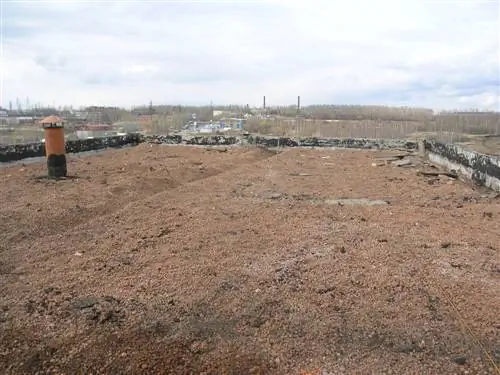
Expanded clay is also used for green roofs
In ecological house building, expanded clay perfects the substrate for green roofs. On the roof, substrate acts as a rooting layer for plants and drainage for water removal. For this purpose, nutritious topsoil enriched with expanded clay is broken. For perfect functionality, the proportion of topsoil should be reduced from top to bottom in order to optimize the drainage effect. It is also recommended to thin out heavily clay-concentrated substrates with fine-grained sand for vital growth of the special green roof plants.
Using expanded clay in the garden - tips & tricks
Natural hobby gardeners have discovered expanded clay as an ideal problem solver for a variety of tasks. Thanks to the airy, light, water-conducting clay balls, the conditions for plant growth can be improved in harmony with nature. What the table above suggests is discussed in more detail in the following sections.
Soil improvement
Garden soil with a high proportion of loam and clay tends to cause serious compaction. Because the rainwater does not drain away or only drains slowly, harmful waterlogging occurs. Vegetable plants, flowers, perennials and woody plants suffer from constantly wet roots and die. By mixing clay granules into heavy garden soil, you can eliminate the problem. This is how you can improve the soil with expanded clay:
- Dig up bed soil two spade deep (optionally additional seven)
- Work in 3 l of mature compost soil per m² of bed area
- mix in a handful of expanded clay for each l of compost soil
- smooth improved garden soil with a rake
To improve the soil, please use expanded clay with a medium grain size of 4 to 10 mm. Finer grain sizes pose the risk of siltation and thus undermine the desired loosening and aeration effect in the soil.
Drainage substrate in raised beds
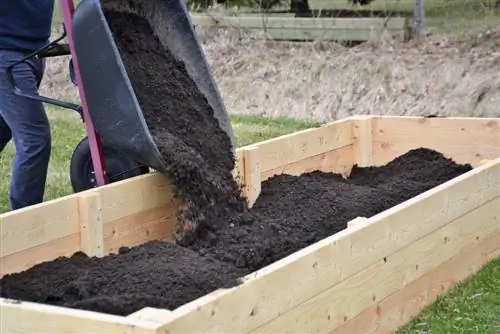
Expanded clay is also good for raised beds
Filling a raised bed correctly requires a good deal of expertise and even more time. Understandably, hobby gardeners are specifically looking for an uncomplicated solution. A clever move is to use a ready-made raised bed filler. The Liapor company is in the lead here with a high-quality special product based on expanded clay. This is how it works:
- Cover the ground in the raised bed with rabbit wire to prevent voles
- add a 30 to 50 cm high layer of raised bed filler on top
- cover with a drainage fleece
- fill in 15 to 25 cm high ripe, sifted compost soil as a planting layer
With the Liapor raised bed filler you use a natural, balanced base and drainage material that protects your plants. Waterlogging, root rot or mold have little chance of affecting vital growth and rich harvest yields. Thanks to the low weight of expanded clay, back-friendly gardening begins as soon as the raised bed is filled.
Tree substrate
Trees go through a delicate phase in the first two years. In order for underground and above-ground growth to proceed smoothly, the best possible conditions in the soil are important. By using expanded clay as an additive in the tree substrate, you can effectively prevent the negative effects of waterlogging on the day of planting. The high firing temperature in the manufacturing process makes expanded clay balls extremely durable. Extreme stress caused by frequent changes between freezing and thawing weather does not prevent clay granules from continuously guaranteeing the best water permeability and permanent soil aeration.
Light chippings
Cracked expanded clay is becoming very popular in creative gardening and landscaping. In contrast to clay balls, broken expanded clay fragments interlock when they are applied to the substrate. Furthermore, expanded clay as a light chippings is frost-resistant, rot-proof and moisture-regulating. The granules only absorb moisture for a short time on the porous surface. Without swelling, excess water is quickly transferred to deeper soil layers for an effective drainage effect. Thanks to a dry bulk density of around 0.5 t/m³, expanded clay is a real lightweight compared to gravel and conventional chippings.
These properties make broken expanded clay the ideal substructure for terraces, garden paths and seating areas. For this purpose, expanded clay granules with a fine grain size are applied as a layer about 4 centimeters high.
Winter grit
Breaking expanded clay is recommended for use as an environmentally friendly winter grit to prevent the risk of slipping. This variant reduces the purchase price by up to 50 percent. Furthermore, the sharp-edged clay granules are much better than pellets for making icy garden paths and driveways slip-proof.
Expanded clay in plant care - instructions for beginners
Once hobby gardeners have learned to appreciate its advantages, they no longer want to be without expanded clay when caring for plants. The following short instructions show you how to extract its benefits from the natural product:
Drainage
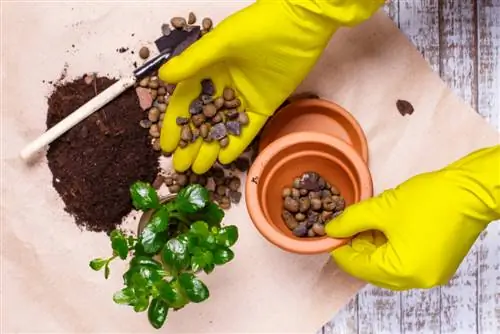
Expanded clay is filled into the flower pot as a drainage layer as the bottom layer
As drainage, expanded clay deserves the rating of excellent. Because the fired clay balls do not absorb the water, but rather pass it on, waterlogging in boxes, buckets and flower pots is a thing of the past. Fill a layer of expanded clay about 5 centimeters high over the floor openings, which you cover in advance with a piece of clay. Excess irrigation and rain water can now drain away quickly. To prevent crumbs of earth from getting between the expanded clay balls, use a drainage fleece. This is an air and water permeable fabric that you spread between the substrate and drainage.
Hydroculture

The good tone for magnificent house plants comes in the form of expanded clay. By placing your soil-bound plants in expanded clay, guesswork about proper water and nutrient supply is a thing of the past. While sophisticated orchids reside in expanded clay, the rainforest beauties indulge in an opulent floral rush. The key word for these motivating, gardening successes is hydroponics. You can also plant large pots with expanded clay using this principle. You need a waterproof planter with a special inner pot, expanded clay, water level indicator and nutrient solution. How to proceed correctly step by step:
- Soak expanded clay for 12 to 24 hours
- Unpot the plant and shake off the soil
- rinse the last remaining substrate residues from the root ball
- Place bare plant roots in the middle of the special inner pot
- Position the water level indicator in the inner pot so that it is easy to read
- Fill expanded clay
- Push the inner pot lightly onto the table to distribute the clay balls evenly
- Place the pot in the waterproof planter
For the first watering, fill in room temperature water up to level 1 on the water level indicator. Expanded clay directs water to the roots using capillary force. In the future you will be able to see from the display when you should water the plant again. Because hydroponic plants cannot survive on water alone, a special nutrient solution ensures the supply of all important nutrients.
Substrate component
The joy of inexpensive potting soil doesn't last long, because compacted substrate in pots and balcony boxes constricts the air from plant roots. This shortcoming does not mean that you will have to forego special offers at the garden center or hardware store in the future. As soon as you mix a little expanded clay with the soil, the substrate will be airy and loosely permeable. Fine clay granules with a grain size of 1 to 4 mm are well suited. Because expanded clay is structurally stable and pressure-resistant, the substrate cannot collapse even after a long period of time. Plants and nature are completely happy when you upgrade peat-free potting soil with expanded clay.

Substrates enriched with expanded clay are airy, loose and permeable
Increase in humidity
Just at the beginning of the heating season, tropical house plants rebel against the dry indoor air. Almost all exotic potted flowers rely on humidity of more than 50 percent. If the value falls below this mark, growth depression and leaf and flower fall are inevitable. This is where expanded clay comes into play to regulate the indoor air without a mechanical humidifier. It's that easy:
- Fill the saucer of a pot or bucket with expanded clay
- Place the container on the expanded clay
- Pour water into the coaster
The water evaporates over the spherical, rough surface and rises as steam. This creates a microclimate in the immediate vicinity of the plant with increased humidity.
Mulch
Weed control is a vexing issue when caring for majestic potted plants and large flower boxes. Primarily woody plants gradually become bald at the base. The exposed surface of the earth gives rise to weeds that spoil the well-kept appearance. Annoying weeding is the annoying result. It doesn't have to come to this if there is a mulch made of expanded clay at the feet of the plants. With a layer height of around 2 centimeters, clay granules suppress the growth of weeds without hindering the water and nutrient supply.
Tip
Contrary to popular belief, expanded clay does not act as a water reservoir. As a result, clay granules do not extend watering intervals when used as an additive in potting soil. The test to the example provides the proof. Place a handful of expanded clay in a glass of water. The beads still float on the surface of the water after hours and do not become saturated.
Buy expanded clay - shopping sources with price comparison
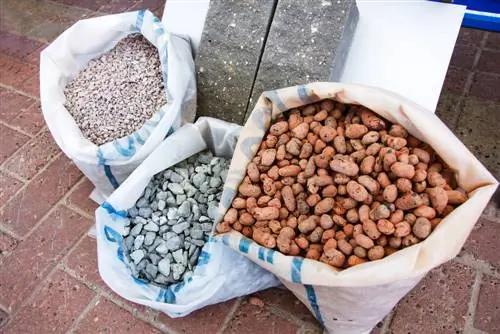
Prices for expanded clay vary greatly depending on the seller
Expanded clay had a niche existence for a long time and was difficult to find in stores. Since word has spread about its environmentally friendly properties, more and more hardware stores are adding the product to their range. We looked around the market to see what the offerings and price structure were like. The following overview lists purchasing sources with price comparisons:
| Providers | Price 2-2, 5 l | Price 5 l | 10l | 50 l |
|---|---|---|---|---|
| Bauhaus | 2, 95 EUR | 10, 95 EUR | 21, 90 EUR | no offer |
| Obi | 2, 69 EUR | 4, 99 EUR | 5, 99 EUR | 18, 99 EUR |
| Toom | 4, 49 EUR | 6, 49 EUR | 9, 49 EUR | no offer |
| Hornbach | 2, 95 EUR | 6, 95 EUR | 9, 99 EUR (15 l) | no offer |
If you want to buy expanded clay cheaply in a 50 l bag, you will rarely find it at well-known hardware stores. Here the offers usually end at 10 l. Larger containers can be found on Amazon from 21.90 euros per 50 l for fine, medium or coarse grain sizes. Hornbach is an exemplary provider for hobby gardeners with a large need for expanded clay. Here you will receive a pallet with 1.260 liters (42 x 30 l) for the price of 605 euros with free shipping.
Please note that this price comparison is a snapshot and does not claim to be representatively up-to-date. As with all products for gardening, plant care and house building, supply and demand determine the price.
Saving hunters buy expanded clay from specialist retailers
When hobby gardeners want to buy a larger amount of expanded clay cheaply, specialist retailers come into focus. Specialist companies for expanded clay as a building material usually offer suitable products for garden and plant care. The Liapor company is in the lead with the brand “Liadrain”, an expanded clay suitable for plants as a substrate component for balcony and terrace greening as well as raised bed filling. At Liapor-shop.de you can purchase a 50 liter bag for 9.58 euros plus shipping costs.
Background
Seramis is not expanded clay
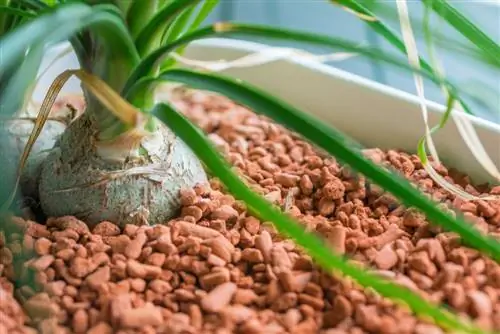
Seramis and expanded clay do not have the same properties
A widespread lack of information about clay granules causes fatal failures in plant care. Many indoor gardeners are under the misconception that Seramis and expanded clay are identical. In fact, there is a significant difference between the two materials. Seramis plant granules contain clay beads that have undergone a special process to increase the pore volume. As a result, the beads absorb water like a sponge. This high water retention is beneficial for soil-bound plants, but unsuitable for hydroponics. In contrast, expanded clay does not store moisture, but operates with ideal water and air circulation, which is vital for all hydroponic plants. As a result, Seramis plant granules are not an alternative to expanded clay, but rather have other advantages.
Expanded clay reduces potting soil consumption
The most beautiful bed and balcony flowers rely on a special substrate. To ensure that geraniums, petunias and azaleas bloom lavishly, hobby gardeners grudgingly dig deep into their pockets to buy high-quality branded products. With expanded clay you put the brakes on consumption and costs. The one-time investment in an adequate supply is worth it, because expanded clay can be used again and again and will not wear out even after several years. This is how the gardening trick works:
- Cover floor openings with curved pottery shards
- Fill the bucket, pot or flower box halfway up with expanded clay (fine to medium grain size)
- Cover expanded clay layer with drainage fleece
- Fill in special potting soil and plant
Instead of drainage fleece, you can use worn-out nylon stockings, which further reduces costs. Fill each stocking with expanded clay and tie a knot at the top. This means that the clay granules are spared from contamination by the substrate and can easily be lifted out of the plant pot at the end of the season and reused the next year.
Frequently asked questions
Is expanded clay poisonous?
Expanded clay is a purely natural product without chemical additives. The manufacturing process is limited to crushing and heating clay. For this reason, with expanded clay you have a completely harmless product in your hands that fulfills a variety of tasks in natural gardens and environmentally friendly house building.
Is there an alternative to expanded clay?
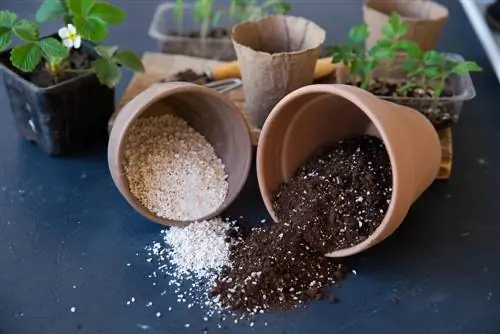
Perlite is often used as a replacement for expanded clay
Perlite is obtained from obsidian, a volcanic rock glass. The natural material goes through a similar manufacturing process to expanded clay and has analogous properties and possible uses. The only outstanding difference is the color of the beads. Perlite is white to cream colored and resembles popcorn. In contrast, expanded clay balls are colored red-brown, light or dark brown. In a direct price comparison, Perlite scores with a price that is up to 50 percent cheaper than expanded clay.
What grain sizes can you buy expanded clay?
Expanded clay with a fine grain size of 1 to 4 mm is suitable as a substrate additive for indoor and balcony plants. Furthermore, fine-grained clay granules are used in house construction as a fill for thermal insulation or soundproofing. With a medium grain size of 4 to 10 mm, expanded clay is used for hydroponics, as drainage in plant containers and for soil improvement. With a coarse grain size of 10 to 20 mm, expanded clay often functions as a building material in ecological house construction. In addition, coarse clay granules are useful as drainage for large potted plants.
Can the advantages of expanded clay be used to create a beautiful lawn on heavy clay soil?
If you are laying a new lawn on heavy clay soil, expanded clay as an additive provides valuable protection against waterlogging. For this purpose, work a layer of 5 to 10 centimeters of expanded clay into the soil when you create the rough subgrade. You can renovate old, mossy lawns with expanded clay and breathe new life into them. You can do this with narrow slots 3 centimeters wide and 5 centimeters deep, which you make into the lawn at a distance of 60 centimeters. Then fill the small furrows with fine-grained expanded clay, sprinkle a compost-sand mix over it and roll the lawn.
Is expanded clay suitable for growing young plants in hydroponics?
In fact, you can plant young plants for hydroponics in expanded clay from day one. Use a grain size of 1 to 4 mm so that the tender roots quickly gain a foothold. Before first use, the clay granules are thoroughly watered. Then fill the growing pot half with expanded clay. Place the young plant on the substrate, distribute the existing roots evenly and fill in the remaining clay granules. Now you can place the pot in a waterproof container and water it to the minimum level. It is important to note that there should be no soil residue on the plant.
Can you use expanded clay as a filter medium for the garden kingdom?
The use of expanded clay as a filter medium is controversial among experienced pond owners. The porous surface of the clay balls is seen as critical. Bacteria, algae and pollution accumulate here over time, which can have a harmful effect on the he alth of fish. To ensure safe use in the pond filter, it should be ensured that expanded clay is regularly and thoroughly cleaned of deposits.
In what proportion should expanded clay be mixed with soil for optimal growth?
If you mix expanded clay with soil in a ratio of 1:9, you can effectively prevent growth disorders. With this mixing ratio you give the soil a permanent loosening and oxygen supply. A higher proportion of expanded clay makes the soil too permeable, which has just as unfavorable an effect on the plants as a structure that is too solid.
What is a drainage fleece?
A drainage fleece has the task of preventing two different soil layers from mixing. This is a special fabric that is permeable to water and air. When combined with expanded clay for plant care, the drainage fleece prevents soil from settling between the clay balls. If you use clay granules as light chippings in the garden, a drainage fleece also serves as a weed fleece.
Tip
As an environmentally friendly natural material, you can dispose of expanded clay in the organic waste bin or on the compost. In view of its many advantages, it is advisable to recycle valuable clay granules, comparable to lava granules. Simply rinse with clean water and the expanded clay is in top shape for reuse.

